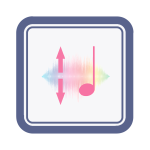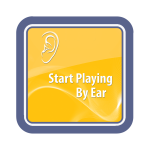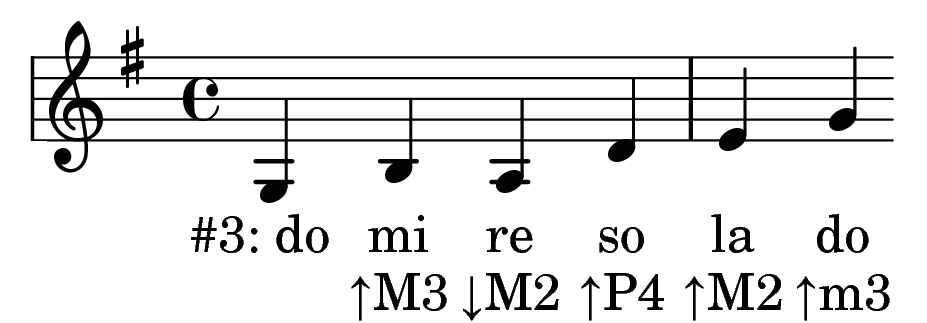Two of the most common questions musicians have about ear training are: “how can I play by ear?” and “what’s the point of intervals?”. In this article I’m going to share a step-by-step approach you can use to learn intervals and put them to practical use to play melodies (tunes) by ear.
Playing melodies by ear is relevant whether you play an instrument like saxophone or violin which tends to play single notes at a time, or an instrument like guitar or piano which tend to player fuller harmonic arrangements. Most music is written based on the melodies and so they are a great place to focus your efforts when learning to play by ear.
It’s also closely related to improvisation, which can be thought of as “playing by ear the melodies you hear in your head”.
 As I said at the start, the sticking points many musicians hit with ear training are that they don’t understand how you actually learn the skill of playing by ear, or they start learning interval recognition but don’t know how to apply those intervals to real musical tasks like playing melodies by ear. By sharing this “Roadmap” for learning to play melodies by ear using intervals I hope to help you avoid these sticking points yourself.
As I said at the start, the sticking points many musicians hit with ear training are that they don’t understand how you actually learn the skill of playing by ear, or they start learning interval recognition but don’t know how to apply those intervals to real musical tasks like playing melodies by ear. By sharing this “Roadmap” for learning to play melodies by ear using intervals I hope to help you avoid these sticking points yourself.
→ See the full Roadmap for playing melodies by ear using intervals
What is an ear training Roadmap?
 Roadmaps are a resource we provide inside Musical U, our training site which offers a full suite of training modules along with personal help and support throughout your musical development. They are our way of helping members to see a clear path ahead of them while still allowing their training plans to be fully personalised and customised to suit their particular needs.
Roadmaps are a resource we provide inside Musical U, our training site which offers a full suite of training modules along with personal help and support throughout your musical development. They are our way of helping members to see a clear path ahead of them while still allowing their training plans to be fully personalised and customised to suit their particular needs.
A Roadmap is designed to answer three questions:
- Where am I?
- Where do I want to go?
- How will I get there?
Roadmaps are written for a particular musical goal (e.g. playing melodies by ear using intervals) and break up the journey into distinct phases. Each phase has clear requirements and outcomes, so simply by reading through the Roadmap you can get a clear picture of which phase you’re currently in, what your next steps should be, and where it can eventually lead you in your musical development.
Musical U members use the Roadmaps to inspire their own personal Training Plan and then share this in the community as part of their Progress Journal. Then they can get help and support from other members and the team and benefit from insights to maintain and even accelerate their training results.
To put the Roadmap into action most effectively requires access to the training modules of Musical U, available to every member as soon as they join. However, simply getting clear on the “big picture” can be hugely valuable too, which is why we’re sharing an outline of the full Roadmap here.

How to play melodies by ear using intervals
Playing a melody by ear is a simple enough concept. You hear a series of notes, one at a time, and then you play them on your instrument without any need for sheet music or guitar tab.
In practice this is highly challenging for most musicians! Unless, of course, they have trained their ears and learned how to do it.
Playing melodies by ear involves a combination of:
- Relative pitch skills
- Rhythm skills
- Instrument skills
Your sense of relative pitch allows you to identify the pitch of each note in the melody (i.e. was that ascending tune “C, F, F, G” or “C, D, D, E”?). Your sense of rhythm lets you play each note with the correct duration. Then instrument skills are required to actually play the notes you intend to play with correct pitch and duration.
In the majority of cases, it’s relative pitch which is the tricky part. If you’ve been learning an instrument for a while then you probably have the basic technical proficiency to play what you want to by ear, and most musicians find the basic rhythm skills come naturally and instinctively. What is much harder is to identify the pitch of each note in the melody, using your sense of relative pitch.
There are two main frameworks for relative pitch: intervals and solfa. You can use either or both to play melodies by ear. At Musical U we encourage our members to explore the training modules for both, see which approach they prefer, and then continue to develop skills in both areas since they are complementary and the most proficient musicians tend to have strong skills with both frameworks.
In this Roadmap we will focus on the approach using intervals.
We begin by learning the fundamentals of interval recognition and training our ear to recognise individual intervals. We focus on those most commonly used in melodies and include instrument exercises from early on. Then we build on this with a thorough grounding in how playing by ear works and how you can learn it, before integrating the intervals and applying them to actually start playing simple melodies by ear on your instrument.
→ See the full Roadmap for playing melodies by ear using intervals
Phase 1: Fundamentals
 Before starting to learn interval recognition and how to play melodies by ear is it important to understand how musical pitch works and the difference between absolute pitch and relative pitch.
Before starting to learn interval recognition and how to play melodies by ear is it important to understand how musical pitch works and the difference between absolute pitch and relative pitch.
With two Ear Expansion modules you quickly discover all the core concepts you need and some fun and interesting aspects of Pitch and Intervals. You find out exactly what your sense of “relative pitch” is and how it will allow you to play melodies by ear.
By the end of this phase you will have a strong foundation in place for learning intervals in an effective way which delivers consistent results.
Phase 2: Intervals Preparation
A frequent mistake made by musicians in ear training is to dive into learning interval recognition without first understanding the options available to them. There are actually three different approaches to learning intervals and each has their strengths and weaknesses.
 In the comprehensive Learning Intervals you learn about all three approaches, as well as practical advice and guidance on how to plan your interval training to ensure continual improvement.
In the comprehensive Learning Intervals you learn about all three approaches, as well as practical advice and guidance on how to plan your interval training to ensure continual improvement.
You will make some key decisions about the approach you will follow and identify the resources that will help you begin learning intervals.
By the end of this phase you will be eager and ready to start your interval training.
Phase 3: Start Learning Intervals!
 This phase covers the regular practice exercises required to train your ears to recognise intervals. Using the specially-designed training and testing tracks, with a sequence of lessons that’s been developed and proven effective over the years at Easy Ear Training, you learn to recognise the core types of interval used in melodies. A set of interactive quizzes help you continually check your skills and see clearly the progress you’re making each day.
This phase covers the regular practice exercises required to train your ears to recognise intervals. Using the specially-designed training and testing tracks, with a sequence of lessons that’s been developed and proven effective over the years at Easy Ear Training, you learn to recognise the core types of interval used in melodies. A set of interactive quizzes help you continually check your skills and see clearly the progress you’re making each day.
To make sure you are developing a skill which will directly help you in your real musical life, this phase also includes instrument-based exercises to help you connect up your ears and the theory with your own instrument and regular music practice.
By the end of this phase you’ll be able to easily and reliably recognise seven types of interval in their ascending and descending forms, and you’ll be ready to start putting them to use to play by ear.
Phase 4: Playing By Ear Preparation
Playing by ear is a widely misunderstood topic, and if you’re going to learn to play melodies by ear using intervals it’s important that you dispel the common myths and get a solid understanding of how this skill works and how it’s learned.
 The Start Playing By Ear module explains the concepts and method, and then The Play-By-Ear Process provides you with detailed walkthrough examples of how a musician would actually go about playing songs by ear.
The Start Playing By Ear module explains the concepts and method, and then The Play-By-Ear Process provides you with detailed walkthrough examples of how a musician would actually go about playing songs by ear.
By the end of this phase you will see clearly how to put your interval skills to use in playing by ear without feeling overwhelmed or confused.
Phase 5: Play Melodies By Ear
By this phase of the Roadmap you have put in place the core skills and understanding you need to play melodies by ear on your instrument and it’s time to start doing it!
 Often what makes the task of playing melodies by ear seem impossible is that musicians try to tackle any song they come across which can present some overly-challenging melodies. In this phase you will instead start with carefully chosen examples based on a particular scale that’s commonly used. This makes the task so simple that you will see immediate success, while still being a real example of playing melodies by ear and helping you move towards the eventual goal of tackling any melody you hear.
Often what makes the task of playing melodies by ear seem impossible is that musicians try to tackle any song they come across which can present some overly-challenging melodies. In this phase you will instead start with carefully chosen examples based on a particular scale that’s commonly used. This makes the task so simple that you will see immediate success, while still being a real example of playing melodies by ear and helping you move towards the eventual goal of tackling any melody you hear.
Here’s an example from one of the training tracks towards the end of this phase demonstrating breaking a melody down into its intervals:
Example: Melody in intervals

Again, exercises are provided which let you directly apply this on your instrument as well as developing the internal listening skills you need. You’ll also see how to connect this with traditional music staff notation.
By the end of this phase you will be able to proudly say that you can play melodies by ear on your instrument.
The end of this Roadmap is of course not the end of your journey in learning to play by ear. However it does represent a substantial and meaningful accomplishment which will leave you with no doubt about being able to go on and tackle increasingly challenging tasks in playing music by ear.
If you’ve ever wondered how a musician can learn to play melodies by ear, or you’ve studied intervals and not known how to actually use them, I hope this Roadmap preview has shed some light and shown you a possible path forwards. If you’re interested to get access to the full Roadmap and all the training modules involved check out Musical U membership. And good luck in your journey towards playing melodies by ear on your instrument!







